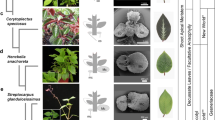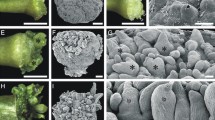Abstract
Shoots of the aquatic eudicot family, Podostemaceae, exhibit unusual organogenesis with mixed leaf and stem identities. New shoots arise at the base of the older shoot with shoot apical meristem (SAM) identity but the entire SAM differentiates into a “leaf” as it develops in the Podostemoideae subfamily. The “leaves” are tightly arranged in a zigzag manner to form an apparent distichous shoot as a whole. Although previous studies have suggested that Podostemoideae shoots have evolved by modifying the ancestral sympodial branching system in the basal Tristichoideae subfamily, this evolutionary scenario requires elucidation at the molecular level. To confirm that the shoots arise as axillary shoots, in the present study, we examined gene expression patterns in plumular shoots of Zeylanidium tailichenoides using CUP-SHAPED COTYLEDON 3 (CUC3) and SHOOT MERISTEMLESS (STM) orthologs, which are involved in the determination of axils and meristem formation in model plants. Expression of the CUC3 ortholog was detected at the adaxial base of cotyledons and parental shoots where the new shoots are initiated, while STM ortholog was expressed at the initiation site and in the young shoot primordia throughout early shoot development. The results demonstrate that each Z. tailichenoides shoot arises as an axillary bud in a manner similar to axillary meristem formation in model plants involving CUC3 and STM genes. Considering that each of the two cotyledons produces an axillary bud that in turn continues to form its own axillary bud independently, the apparent distichous shoot in Z.tailichenoides is not a single shoot, but a composite of two sympodially branched shoots.



Similar content being viewed by others
References
Aida M, Ishida T, Fukaki H et al (1997) Genes involved in organ separation in Arabidopsis: an analysis of the cup-shaped cotyledon mutant. Plant Cell 9:841–857
Bell AD (2008) Plant form: an illustrated guide to flowering plant morphology. Timber Press, Portland
Cook CDK, Rutishauser R (2007) Podostemaceae. In: Kubitzki K (ed) The families and genera of vascular plants. Springer, Berlin, pp 304–344
Fujinami R, Imaichi R (2009) Developmental anatomy of Terniopsis malayana (Podostemaceae, subfamily Tristichoideae), with implications for body plan evolution. J Plant Res 122:551–558
Fujinami R, Imaichi R (2015) Developmental morphology of flattened shoots in Dalzellia ubonensis and Indodalzellia gracilis with implications for the evolution of diversified shoot morphologies in the subfamily Tristichoideae (Podostemaceae). Am J Bot 102:848–859
Fujinami R, Ghogue JP, Imaichi R (2013) Developmental morphology of the controversial ramulus organ of Tristicha trifaria (subfamily Tristichoideae, Podostemaceae): implications for evolution of a unique body plan in Podostemaceae. Int J Plant Sci 174:609–618
Hammond BL (1936) Regeneration of Podostemon ceratophyllum. Bot Gaz 97:834–845
Hibara KI, Karim MR, Takada S et al (2006) Arabidopsis CUP-SHAPED COTYLEDON3 regulates postembryonic shoot meristem and organ boundary formation. Plant Cell 18:2946–2957
Imaichi R, Hiyama Y, Kato M (2005) Leaf development in the absence of a shoot apical meristem in Zeylanidium subulatum (Podostemaceae). Ann Bot 96:51–58
Jäger-Zürn I (1997) Comparative morphology of the vegetative structures of Tristicha trifaria, Indotristicha ramosissima and Dalzellia ceylanica (Podostemaceae, Tristichoideae): a review. Aquat Bot 57:71–96
Katayama N, Koi S, Kato M (2010) Expression of shoot meristemless, wuschel, and a symmetric leaves1 homologs in the shoots of Podostemaceae: implications for the evolution of novel shoot organogenesis. Plant Cell 22:2131–2140
Katayama N, Kato M, Yamada T (2013) Origin and development of the cryptic shoot meristem in Zeylanidium lichenoides (Podostemaceae). Am J Bot 100:635–646
Kato M, Koi S (2018) Molecular phylogeny of Zeylanidium (Podostemaceae) showing a new cryptic species from Thailand. Acta Phytotax Geobot 69:1–9
Katoh K (2005) MAFFT version 5: improvement in accuracy of multiple sequence alignment. Nucl Acids Res 33:511–518
Katoh K, Toh H (2008) Recent developments in the MAFFT multiple sequence alignment program. Brief Bioinform 9:286–298
Kita Y, Kato M (2001) Infrafamilial phylogeny of the aquatic angiosperm Podostemaceae inferred from the nucleotide sequences of the matK gene. Plant Biol (Stuttg) 3:156–163
Kita Y, Kato M (2005) Seedling developmental anatomy of an undescribed Malaccotristicha species (Podostemaceae, subfamily Tristichoideae) with implications for body plan evolution. Plant Syst Evol 254:221–232
Koi S, Katayama N (2013) Gene expression analysis of aquatic angiosperms podostemaceae to gain insight into the evolution of their enigmatic morphology. Methods Mol Biol 959:83–95
Koi S, Kato M (2007) Developmental Morphology of the Shoot in Weddellina squamulosa and implications for shoot evolution in the Podostemaceae. Ann Bot 99:1121–1130
Koi S, Imaichi R, Kato M (2005) Endogenous leaf initiation in the apical-meristemless shoot of Cladopus queenslandicus (Podostemaceae) and implications for evolution of shoot morphology. Int J Plant Sci 166:199–206
Koi S, Kita Y, Hirayama Y et al (2012) Molecular phylogenetic analysis of Podostemaceae: implications for taxonomy of major groups. Bot J Linn Soc 169:461–492
Larkin MA, Blackshields G, Brown NP et al (2007) Clustal W and Clustal X version 2.0. Bioinformatics 23:2947–2948
Mohan Ram H, Sehgal A (1997) In vitro studies on developmental morphology of Indian Podostemaceae. Aquat Bot 57:97–132
Moline P, Thiv M, Ameka G et al (2007) Comparative morphology and molecular systematics of African Podostemaceae-Podostemoideae, with emphasis on Dicraeanthus and Ledermanniella from Cameroon. Int J Plant Sci 168:159–180
Raman S, Greb T, Peaucelle A et al (2008) Interplay of miR164, CUP-SHAPED COTYLEDON genes and LATERAL SUPPRESSOR controls axillary meristem formation in Arabidopsis thaliana. Plant J 55:65–76
Rutishauser R (1995) Developmental patterns of leaves in podostemaceae compared with more typical flowering plants—saltational evolution and fuzzy morphology. Can J Bot 73:1305–1317
Rutishauser R, Grubert M (1999) The architecture of Mourera fluviatilis (Podostemaceae): developmental morphology of inflorescences, flowers, and seedlings. Am J Bot 86:907–922
Rutishauser R, Grubert M (2000) Developmental morphology of Apinagia multibranchiata (Podostemaceae) from the Venezuelan Guyanas. Bot J Linn Soc 132:299–323
Sehgal A, Khurana JP, Sethi M et al (2007) Organ identity of the thalloid plant body of Griffithella hookeriana and Polypleurum stylosum—Podostemoideae (Podostemaceae). Plant Syst Evol 267:93–104
Steeves TA, Sussex IM (1989) Patterns in plant development. Cambridge University Press, New York
Suzuki K, Kita Y, Kato M (2002) Comparative developmental anatomy of seedlings in nine species of podostemaceae (subfamily Podostemoideae). Ann Bot 89:755–765
Vroemen CW, Mordhorst AP, Albrecht C, Kwaaitaal MACJ. de Vries SC (2003) The CUP-SHAPED COTYLEDON3 gene is required for boundary and shoot meristem formation in Arabidopsis. Plant Cell 15:1563–1577
Wurdack KJ, Davis CC (2009) Malpighiales phylogenetics: gaining ground on one of the most recalcitrant clades in the angiosperm tree of life. Am J Bot 96:1551–1570
Acknowledgements
The authors would like to thank T. Wongprasert, M. Kato and S. Koi for their help during the collection trips in Thailand. We thank Y. Hirayama for providing a part of anatomical data. This study was supported by a Research Fellowship to N.K. and a Grant-in-Aid for Scientific Research to M.K. from the Japan Society for the Promotion of Science.
Author information
Authors and Affiliations
Corresponding author
Additional information
Publisher's Note
Springer Nature remains neutral with regard to jurisdictional claims in published maps and institutional affiliations
Electronic supplementary material
Below is the link to the electronic supplementary material.
Rights and permissions
About this article
Cite this article
Katayama, N., Tanaka, R., Fujinami, R. et al. Expression pattern of CUC3 ortholog in Zeylanidium tailichenoides (Podostemaceae) infers organization of a unique distichous shoot in Podostemoideae. J Plant Res 132, 521–529 (2019). https://doi.org/10.1007/s10265-019-01113-x
Received:
Accepted:
Published:
Issue Date:
DOI: https://doi.org/10.1007/s10265-019-01113-x




